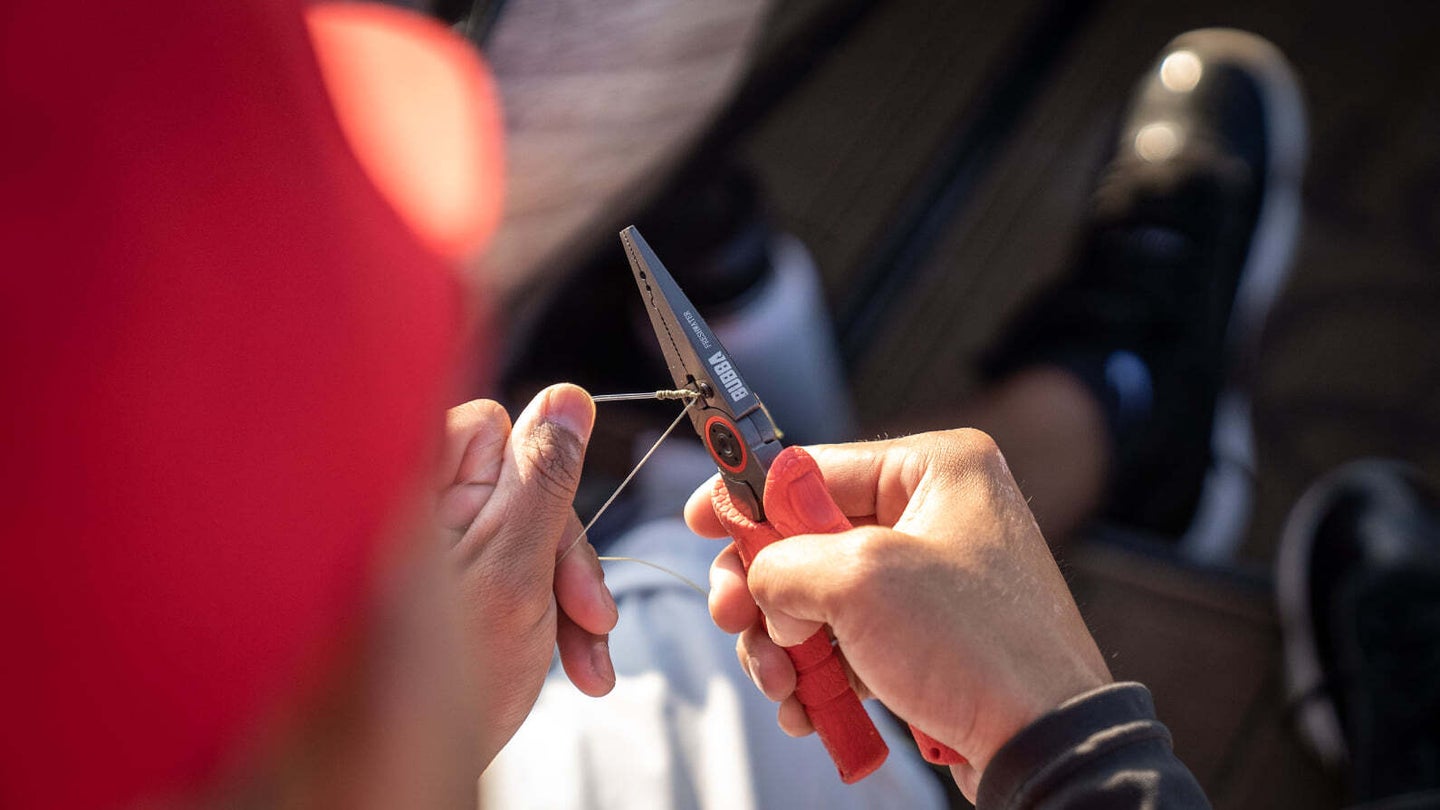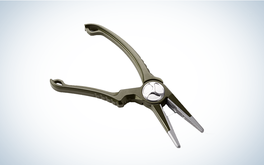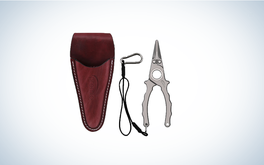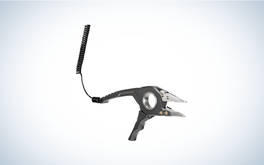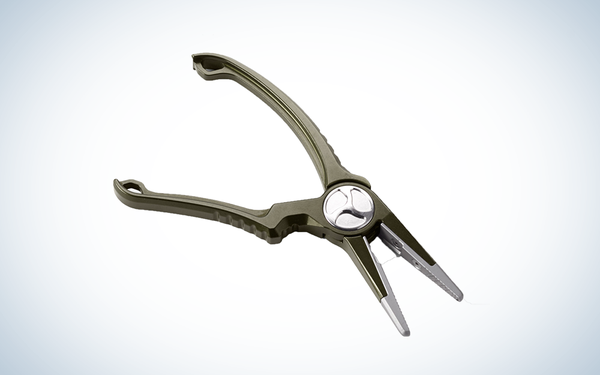We may earn revenue from the products available on this page and participate in affiliate programs. Learn more ›
Fishing pliers are a necessity for just about every angling situation, and the best ones are those that fit a specific set of conditions or a particular angling endeavor. Whether you’re looking to unhook big fish or small fish, cut braided line, crimp split shot or open split rings, there’s a set of pliers that’ll fit your needs. Depending on how rough you are on them, or where and how you fish, you may need to opt for a specific component, too.
Unfortunately, most anglers don’t realize that they have incorrect or insufficient pliers until it’s too late. That’s why it’s vital to figure out which are the best fishing pliers for you.
- Best Overall: Orvis Mirage Pliers
- Best Saltwater: 6 1/3” Premio Titanium Pliers
- Best for Fly Fishing: Simms Flyweight Pliers
- Best Titanium: Van Staal Titanium Pliers
- Best Split Ring: Texas Tackle Split Ring Pliers
- Best Budget: Bubba Fishing Pliers
- Best with Sheath: Rapala Elite Pliers
- Best for Cutting Braid: Gerber Linedriver Multi-Tool
- Best Multi-Purpose: Leatherman Surge
How We Picked the Best Fishing Pliers
The best fishing pliers category can be an overwhelming mountain to tackle. No two anglers have the same needs, the same expectations, or the same budget. My own experience and opinions about fishing pliers were honed earlier in my fishing career when my wallet’s stretch was more limited. I consistently bought low-grade pliers and tools with the expectation that I’d either drop them overboard or otherwise need to replace them on a regular basis.
That proved to be a poor strategy because they rarely did anything well. And when I needed them most, they’d be rusted or simply not up to the task. I tried multi-tools and still carry one when I travel, especially if I’ll be partaking in an unfamiliar type of fishing.
Increasingly, though, on my home waters and in my own boat, I’ve moved toward specialized gear. My boat has a tool holder and I’d rather fill it with items that accomplish a particular task, like cutting braid or opening split rings flawlessly, instead of something that does many jobs poorly or just reasonably well. I evaluate products using the following criteria:
- Durability: Whether it’s in my suitcase getting jostled by luggage handlers or in the tool holder of my bass boat getting bounced around at 70 miles per hour, I’m rough on gear. I don’t necessarily clean it up or put it away after every trip, and it’s going to be exposed to the elements. I need tools that perform when duty calls.
- Cost: Does it provide good value? I’m not above spending a lot of money on any piece of fishing equipment, so long as it does the job that’s needed and does it well for the long haul. I’ve learned the hard way that buying junk leads to the need to make another purchase.
- Specialization vs. Wide-Ranging Utility: I may sacrifice best-in-class service for a particular function if a tool can handle multiple tasks. On a long-distance trip, I don’t want to bring five or six tools. In my own boat, I have space for the best of the best.
Best Fishing Pliers: Reviews & Recommendations
Best Overall: Orvis Mirage Pliers
Specs
- Length: 6 1/4”
- Features: Lightweight construction and replaceable cutters
- Sheath: Leather sheath
Pros
- Incredibly light
- Long jaws are easy to grab hooks with
- Type 3 anodizing prevents corrosion
Cons
- Expensive
The Mirage Pliers are built from anodized aluminum. This allows for a slim profile that is both lightweight and corrosion-resistant. They are incredibly comfortable to use and practically disappear on your hip. This attention to detail continues throughout the design. The jaws are flat but feature an aggressive cross pattern for plenty of grip. On the back part of the jaw is the line cutter, capable of cutting just about anything you throw at it. The jaws and cutter are one piece, meaning when you change the cutters, you get a fresh set of jaws. While they are expensive, a removable lanyard minimizes the chance of losing them, and they are built in the USA. —MI
Best Saltwater: 6 1/3” Premio Titanium Pliers
Specs
- Length: 6 1/3 inches
- Features: Replaceable line cutter and removable lanyard
- Sheath: Leather sheath
Pros
- Reasonably priced
- Comfortable leather sheath
- Removable lanyard prevents loss
Cons
- Cutters are in the jaw rather than the side
The Premio series of pliers from Danco are priced right and built for the salt. They aren’t overly expensive, which is surprising considering the 100 percent machined titanium construction. In the salt, titanium is as good as it gets when it comes to corrosion resistance. The jaws feature a smooth tip and an aggressively cut rear for hooks of all sizes. At 6 1/3 inches, they have plenty of length for inshore and smaller offshore fish, even Barracuda. The back of the jaws features replaceable line cutters capable of cutting braid, mono, fluoro, and light steel in a pinch. This all comes with a comfortable leather sheath and a removable lanyard to keep your investment on your hip and not in the drink. —MI
Best for Fly Fishing: Simms Flyweight Pliers
Specs
- Length: 5 ¾”
- Features: Removable lanyard and quick grab sheath
- Sheath: Plastic holster
Pros
- Ergonomic shape
- Long lanyard
- Lightweight feel
Cons
- Plier tips grab line sometimes
Simms lives and breathes fly fishing, so it’s natural that their Flyweight plier is up to the task. The ergonomic design brings your hand much closer to the jaws. The result is more precision and a smaller feel in the hand, similar to a hemostat. Fly anglers can easily crimp split shots and pinch barbs while also unhooking meaty streamer hooks. A long lanyard makes it easy to work on fish or throw it to your buddy who forgot his at home. The holster does a great job of keeping the pliers at the ready, but the tips of the jaws do not fully close. If you’re not careful where you position them, the fly line will catch the jaws. —MI
Best Titanium: Van Staal Titanium Pliers
Specs
- Length: 7 inches
- Features: Replaceable line cutters
- Sheath: Leather sheath with attached lanyard for security
Pros
- Lightweight and strong
- Replaceable cutting blades
- Stylish sheath
Cons
- Not suitable for every budget
Van Staal describes their product lineup as having “no limitations”. And indeed these titanium pliers are a premium tool, packing a lot of features into an exceedingly lightweight product. They feature channel cut jaws for maximum holding power and spring-loaded ergonomic handles that keep the pliers open and ready for action. This keeps you safe and your quarry secure.
The replaceable tungsten cutter and anvil cleanly cut all kinds of lines, with a special configuration that keeps your line in position to get snipped. They just seem to get better with age, too. So, it’s a good thing that they come with a sheath and lanyard, which means you have no excuse not to pass them on to the next generation. —PR
Best Split Ring: Texas Tackle Split Ring Pliers
Specs
- Length: 4 or 5 inch
- Features: Split ring-specific jaws
- Sheath: Not included
Pros
- Simple to operate
- Non-slip grip
- Inexpensive
Cons
- Limited functions
If you’re ever suffered through missed hookups because you couldn’t replace a dull treble hook, or painfully broken a fingernail when trying to swap one out, this product is for you. They are precision-made to creep into the smallest openings with single-hand operation and then hold them open as long as necessary thanks to an integrated spring.
Surgical-quality stainless steel construction means that they won’t rust, dull or disintegrate over time. So, you can throw them in the boat or in your tackle bag and be sure that they’ll still be ready to go when needed. These pliers come in multiple sizes to accommodate varying types of split rings. —PR
Best Budget: Bubba Fishing Pliers
Specs
- Length: 6.5, 7.5, 8.5 inch, in both straight and pistol grip designs
- Features: Carbide cutters, split shot and leader sleeve crimps
- Sheath: Included, with belt loop
Pros
- Lots of features in an inexpensive package
- Ergonomically friendly
- Sheath and lanyard attachments make them unlikely to be lost
Cons
- Not as light as some higher-priced models
These pliers may look rather standard at first glance, but Bubba packs a lot of functionality into a durable and affordable package. They’re made of stainless steel, and have durable and powerful carbide cutters to handle any line that needs snipping with a minimum of effort. Add in the dedicated features aimed at crimping split-shots and leaders and you have a one stop shop for angling excellence and efficiency.
These pliers are spring-loaded, so one hand is all that you need to operate them. Fortunately, the non-slip grip means that one hand will be sufficient to hang on to them. The pistol grip models give anglers a unique, unobstructed line of sight that allows them to see into the fishes’ mouth when unhooking them. Various sizes and both straight and pistol-grip handles mean that there’s a Bubba option no matter what you chase and where you do it. —PR
Best with Sheath: Rapala Elite Pliers
Specs
- Length: 7 inches
- Features: Multiple, including crimping tool
- Sheath: Included neoprene sheath, coil lanyard and carabiner
Pros
- Replaceable carbide cutters
- Interlocking “teeth” keep a tight grip
- Resistant to harsh elements
Cons
- Not as durable as titanium models
Rapala has long offered a number of different tools, including various pliers. But the Elite pliers take their offerings to the next level. They’re developed with ergonomics in mind and have tons of features, including a crimping tool. Every possible failure point is oversized and beefed up to maintain integrity, without adding substantial weight. This includes the magnetically actuated “Mag Spring” meant to keep the pliers open to the “Mag Lock” that keeps them closed when necessary.
The carbide cutters are super-sharp, and can be replaced if they ever get dull. These pliers are even covered in a substance that makes them impervious to corrosion and UV degradation, too, which means they’ll last a long time. That length of ownership is further helped by the included sheath, coil lanyard, and carabiner. So you can keep your hands on your fishing reel and not worry about your pliers ending up in the drink. —PR
Best for Cutting Braid: Gerber Linedriver Multi-Tool
Specs
- Length: 5 inches
- Features: Line management tools including serrated scissors, hook threader, and eyelet cleaning spike
- Sheath: No sheath, but pocket clip and tether point provided
Pros
- Nothing else like it on the market today
- Lightweight aluminum construction
- Two-position line cutter
Cons
- Does not fulfill traditional functions of pliers
Gerber thought completely outside of the box when it developed this tool aimed at line management. Everything about this tool is designed to make an angler’s life easier, including tying better and cleaner knots. The unique tool can be hung from a retractor, clipped to a D-ring, or stashed into a pocket so it’s always at the ready.
The serrated scissor blades can be operated from either of two distinct positions: the first is “unlocked,” from which thicker lines can be placed through and easily cut. The second is from the closed or locked position, which still offers a slight gap through which thinner lines can be cut.
But cutting line—specifically braided fishing line—isn’t all this innovative piece of gear can accomplish. It also has a spike that will clear eyelets, a system for threading hooks, even a split-shot crimper. A unique spinning hook vise simplifies knot tying. This lightweight aluminum tool is the perfect complement to a set of traditional pliers, and offers a limited lifetime warranty. —PR
Best Multi-Purpose: Leatherman Surge
Specs
- Length: 4.5 inches
- Features: Foldable design with over 20 different tools included
- Sheath: Black nylon sheath included, plus a lanyard ring
Pros
- One-stop shop for on-the-water needs
- Heavy-duty construction stands up to rough use
- Replaceable parts
Cons
- Priced above discount models
Packing the Surge in your pocket or on your belt is like taking an entire tool box with you on every fishing trip. Yes, there are tools that make life on the water easier, such as pliers, extra-large scissors and full-size knife blades. But you also get features that other tools in this class don’t offer. They include replaceable wire cutters, wire strippers, a saw, a ruler, can opener, bottle opener and various others.
All of the tools can be opened with one hand, even those that aren’t immediately accessible from the outside. Leatherman is so confident in this tool’s durability that the Surge comes with a 25-year warranty. Upgrade by adding the bit kit and driver extension or ratchet driver to make this package even more functional. —PR
What to Consider When Choosing Fishing Pliers
It can be overwhelming to consider the multitudes of sizes, styles, and designs of pliers that are available today. Anglers might be tempted to use generalized hardware store models in a pinch. But it’s increasingly possible to find precision tools that will last longer, do more, and do it better. Here is what you need to consider:
Fishing Conditions
Where you fish and what you fish for are critical elements of the decision-making process. If you’ll be on foot, that requires a set that will clip to your belt or fold up to slide into a pocket. If you’re in a boat you may want your pliers to be differently accessible, but you might also want them to float if you’re a klutz. And saltwater is the ultimate test of their durability—when you go to use them in a must-have scenario and they’re rusted together you might as well have none at all.
Fish Species
The tool needed to take a size 16 dry fly out of the dainty mouth of a mountain trout differs from that utilized for billfish, with multiple gradations in between. Their respective classes of fishing tackle require different tools. This is not only because the size of the gear varies so much, but because it’s used for so many distinct and different purposes.
Intended Purposes
If you’re looking for a tool for a specific purpose, like crimping wire, cutting braided line or opening split rings, you’ll need a tool that accomplishes that goal in an exemplary fashion. You can choose a more generalist design, but you may have to compromise on the efficacy of certain features—or pay more to get the best of the best across the board. If you don’t know exactly what you want or need, a multitool may suffice. But you never want to employ something that doesn’t do anything well at all. That’s asking for injury to you or your prized catch, and possibly a return trip to the store to buy another set.
Cost
What is your budget? What do you need to spend to get a bare bones qualifier, and what would it take to improve to the cream of the crop? If you’re prone to dropping things in the drink or letting them rust, assume that you may need to invest in a new set again at some point in the future, if not every year.
Tips for Storing
Storing pliers is fairly straightforward, thanks to new, corrosion-resistant materials. After a day of fishing in saltwater, aluminum and titanium pliers need little maintenance; a simple wash and dry in freshwater will do the job. For steel pliers, it’s important to wash and dry them thoroughly and add some WD40 to moving parts. After they dry completely, it is back in the sheath, and return them to your pack or boat so you have them next time you’re on the water.
FAQs
Q: Can I use regular pliers for fishing?
If by regular pliers you mean the type found in a hardware store or even a discount store, the answer is yes. Of course, these can range in quality and price from just a few bucks up into the hundreds for specialized tools.
But if you’re looking for durability and functionality, you will likely have to aim for the middle- to upper-end of this spectrum to get good service. The cheapest ones rarely last. Fishing-specific pliers are often a better investment because they give you multiple tools and functions in one compact package.
Q: How do you use split ring pliers for fishing lures?
Split ring pliers typically have a small, pointed surface that fits into the gap in a split ring, allowing you to open it without damage. That provides the ability to slip off the old hook by rotating the ring in the appropriate direction. Then you can replace it with a new one by reversing the process.
Split ring pliers can be used to remove swivels from lures, and blades from spinnerbaits. But most often they’re employed to change out hooks; either one treble for another, or a single in the place of a treble.
Q: Why do you need pliers when fishing?
Pliers serve a remarkable number of functions when fishing. First and perhaps foremost, they allow you to unhook a fish quickly and efficiently. This prevents further harm if your quarry is to be released.
Some pliers are also designed to serve other roles, such as cutting lines, crimping weights and leaders. You’ll be surprised at how often you use them for non-fishing tasks, too, including fixing loose boat parts or opening a bottle or can.
Q: How do I unhook a fish with pliers?
Unhooking a fish is fairly straightforward. First, open the fish’s mouth and locate the hook. Using the pliers, grab the hook as close to the bend as possible. This maximizes leverage and pops the hook out the easiest. Once you grab the hook, a simple twisting motion should pop the hook free. For deeply hooked fish, long-nosed pliers help grab the hook and minimize stress on the fish.
Q: What’s the best material for fishing pliers?
The best materials for fishing pliers are titanium and aluminum. Titanium offers the best corrosion resistance and strength-to-weight ratio. That said, it is an expensive material to mill, and the end price reflects that. Aluminum is the next best thing. It is lightweight and much better than steel in terms of corrosion resistance. Depending on the plier, the price will vary, but there are plenty of affordable aluminum options available.
Best Fishing Pliers: Final Thoughts
- Best Overall: Orvis Mirage Pliers
- Best Saltwater: 6 1/3” Premio Titanium Pliers
- Best for Fly Fishing: Simms Flyweight Pliers
- Best Titanium: Van Staal Titanium Pliers
- Best Split Ring: Texas Tackle Split Ring Pliers
- Best Budget: Bubba Fishing Pliers
- Best with Sheath: Rapala Elite Pliers
- Best for Cutting Braid: Gerber Linedriver Multi-Tool
- Best Multi-Purpose: Leatherman Surge
Just as every lure is a specific tool aimed at a certain type of fish and a way of catching them, savvy anglers know that buying the right tools makes your time on the water more efficient and enjoyable. Consider the jobs and challenges that may arise during your average fishing day, and find a set of pliers that works for you. If you’re chasing marlin on the high seas, you might need something vastly different than if you’re taking the kids out for a day of whacking on bluegills, but there’s a right tool for each one of those scenarios.
Why Trust Us
For more than 125 years, Field & Stream has been providing readers with honest and authentic coverage of outdoor gear. Our writers and editors eat, sleep, and breathe the outdoors, and that passion comes through in our product reviews. You can count on F&S to keep you up to date on the best new gear. And when we write about a product—whether it’s a bass lure or a backpack—we cover the good and the bad, so you know exactly what to expect before you decide to make a purchase.
